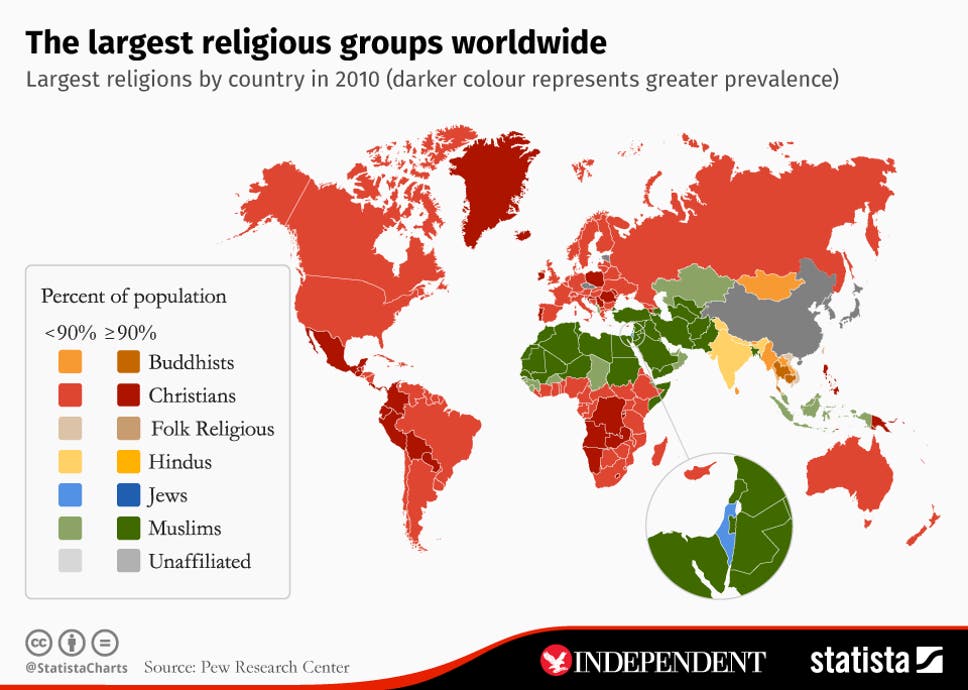Religions of the World
Contents:
Religions with many followers in developing countries — where birth rates are high, and infant mortality rates have in general been falling — are likely to grow quickly.
- Ich will auch mal Kanzler werden...: 999 Fotowitze aus der Berliner Republik (German Edition)!
- Largest Religions In The World?
- APSA conference roundup: Research on political polarization on social media and the U.S. Congress?
- TO LOVE & PROTECT (1).
- One Incredible Savior: Celebrating the Majesty of the Manger!
The low birth rate in China and Japan will also see falling numbers of Buddhists, as a proportion of the world population, by , although the absolute number will remain stable, at around million. Another important factor for the growth of religion is the current age distribution of each faith group.
Hinduism and its beliefs
All the remaining groups have smaller-than-average youth populations, and many of them have disproportionately high numbers of followers over the age of It must be noted that conversion patterns are complex and varied, so Pew has provided full details of its methodology and research, excluding conversion data.
Over the next 30 years Christianity is expected to experience the largest net losses from religious switching, with million predicted to leave the faith and only about 40 million people entering it as converts. Pew has pointed out, however, that the research was conducted with current population data and assumptions made about demographic trends.
- Foursome (erotica, BDSM);
- 10. Cao Dai (6.7 million followers).
- Which is the world's fastest-growing major religion?;
This means many factors could alter the trajectories predicted in the report. Alternatively, if disaffiliation were to become common in countries with large Muslim populations, as it is now in some countries with large Christian populations such as the United Kingdom, the rise in the number of Muslims worldwide would be less dramatic.
What are the most widely practiced religions of the world?
How religious will the world be in ? How strongly do different nationalities feel about religion? In Germany alone, there were an estimated 1.

In fact, Muslims and the unaffiliated in Europe both experienced natural increases in their populations, with our new report estimating that there were over 2 million and 1 million more births than deaths, respectively, between and Globally, Muslims make up the second largest religious group, with 1. Muslims experienced the greatest natural increase among all religious groups, including Christians. Births to Muslims between and outnumbered deaths by million million births vs.
Globally, all major groups had more births than deaths.

Not all babies will remain in the religion of their mother, of course. In some countries, including the United States, it is fairly common for adults to leave their childhood religion and switch to another faith or no faith.
The faith can trace its roots all the way back to prehistory. Growing up with a cocaine addict. The low birth rate in China and Japan will also see falling numbers of Buddhists, as a proportion of the world population, by , although the absolute number will remain stable, at around million. The Parliament spurred the creation of a dozen privately funded lectures with the intent of informing people of the diversity of religious experience: The Invention of World Religions:
Globally, however, the effect of religious switching is overshadowed by the impact of differences in fertility and mortality. Indeed, fertility differences between religious groups are one of the key factors behind current population trends and will be important for future growth. Globally, Muslims have the highest fertility rate of any religious group — an average of 2.
This fertility advantage is one reason why Muslims are expected to catch up with Christians in absolute number and as a share of the global population in the coming decades. Archived from the original PDF on 16 October Retrieved 1 July Retrieved 14 February International Religious Freedom Report US Department of State: Archived from the original on Retrieved 8 November Archived from the original PDF on 25 July Archived from the original on 23 April Mapping the Global Muslim Population: Archived from the original PDF on August 5, How many Shia are there in the world?
Archived from the original on 8 April Archived from the original on 3 February Archived from the original on 5 June Retrieved 23 May Archived from the original PDF on Retrieved 20 November Religion is belief in Almighty God that must be possessed by every human being. Book of "Dealing with Apostates " ". Atheist Statistics - Agnostic". Contemporary Rates and Patterns - Phil Zuckerman".
Archived from the original on 21 October Retrieved 7 February Office for National Statistics. Africa The World Today Series.
Navigation menu
Harpers Ferry, West Virginia: Stryker-Post Publications , p. Archived from the original on 7 April Bureau of Democracy, Human Rights, and Labor. Archived from the original on 6 July Archived from the original PDF on 16 June The Encyclopedia of New Zealand.
- Human Mitochondrial DNA and the Evolution of Homo sapiens: 18 (Nucleic Acids and Molecular Biology)
- Contes choisis de la famille (French Edition)
- Spirit Maps: Follow the Exquisite Geometry of Art and Nature Back to Your Center
- Sorrows of Young William
- Brooklyns ABC Game - A Camp Fire Game
- The Wild Asss Skin: (La Peau De Chagrin) (Classics)